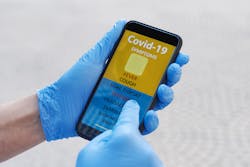A new study reveals that about two-thirds of U.S. and U.K. residents who had tested positive for COVID-19 had self-reported loss of smell and taste via a smartphone app.
The study, recently published in Nature, from researchers affiliated with King's College London, Massachusetts General Hospital, Harvard Medical School, and elsewhere, is a positive sign that digital health apps could be effective in predicting COVID infections. More than 2.6 million participants reported their potential symptoms of COVID-19 on a smartphone-based app, a symptom tracker tool that was launched in late March for free. The study collected data from users between March 24 and April 21. Of those 2.6 million patients, about 18,400 actually took the COVID-19 test; the average age of U.K. testers was 42, and 46.5 in the U.S.
According to the study’s authors, the app collects data from both asymptomatic and symptomatic individuals and tracks in real-time how the disease progresses by recording self-reported health information on a daily basis, including symptoms, hospitalization, reverse-transcription PCR (RT-PCR) test outcomes, demographic information and pre-existing medical conditions.
Of the more than 2.4 million study participants in the U.K. sample, just over 15,000 underwent a COVID-19 test, with about 41 percent (6,452) testing positive. From those who tested positive, the most frequent self-reported symptom was indeed loss of smell and taste, with 65 percent of users reporting it.
In the U.S. sample, nearly 2,800 individuals took a COVID-19 test, with 26 percent testing positive. From that positive sample, the most frequent self-reported symptom was again loss of smell and taste, with 67 percent reporting it.
Meanwhile, just 17 percent of U.S.-based testers and 23 percent of testers in the U.K. who reported this symptom ended up with a negative result. As such, the data shows that loss of taste and smell was the top predictor of whether a person was going to test positive for COVID-19 or not.
According to a New York Times report on the study, Dr. Tim Spector, a professor of genetic epidemiology at King’s College London and a lead author of the study, noted, “It’s just such a weird symptom that doesn’t occur with most other diseases so it’s rarely wrong.” He added in the interview with the NYT that health officials could act on information provided by a surveillance app to encourage participants to isolate themselves until they were able to get tested.
Other common self-reported symptoms from patients who tested positive were the expected ones: persistent coughs, skipped meals, and chest pains. Interestingly, however, about 40 percent of patients in both the U.S. and U.K. who self-reported chest pains and persistent coughs tended up testing negative.
According to the study’s researchers, “Our work suggests that loss of sense of smell and taste could be included as part of routine screening for COVID-19 and should be added to the symptom list currently developed by the World Health Organization. A detailed study on the natural history of broader COVID-19 symptoms, especially according to timing and frequency, will help us to understand the usefulness of symptom tracking and modeling, and to identify probable clusters of infection.”
A model combining symptoms to predict probable infection was applied to the data from all app users who reported symptoms—more than 800,000—and predicted that 140,312 (17.42%) participants are likely to have COVID-19.


